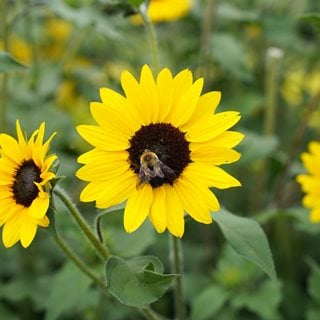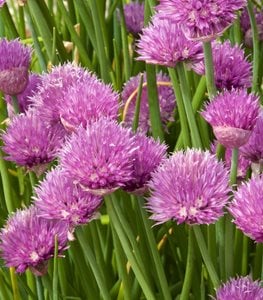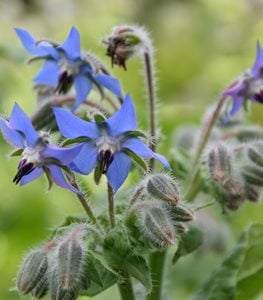FLOWERS FOR A BEE-FRIENDLY GARDEN Posted on Jul 20 2021
Bees help your garden thrive, so treat them well by growing some or all of these bee-friendly plants.
Which came first, the bee or the bee balm? While the question may be interesting to contemplate, it illustrates the vital partnership between plant and pollinator, and how one needs the other in order to survive.
Bee populations are declining rapidly in many regions of the country, with habitat loss being a primary cause. As gardeners, we can do our part to help keep these important pollinators well fed. Growing a diverse variety of flowering plants can satisfy the appetites of various bee species. Along with planting lots of their favorite flowers, we can also improve the environment for bees by creating a safe haven in our gardens that they can call home.
14 FLOWERS FOR BEES
BEE BALM
Plant type: Perennial
Bloom time: Midsummer to early fall
Flower color: Shades of red, pink, lavender, white, or purple. Also, spotted bee balm with pale yellow petals spotted with purple, with showy pink bracts.
Height: 1 to 3 feet tall
Zones: 3-8
Bee appeal: Dense clusters of small two-lipped flowers entice a broad range of pollinators, as do the aromatic green leaves.
Learn more about growing bee balm.
BLUE GLOBE ALLIUM
Plant type: Bulb
Bloom time: May to June
Flower color: Sky blue
Height: 1 to 2 feet tall
Zones: 4-8
Bee appeal: One of the best spring-blooming bulbs for bees, beckoning them from far and wide with its eye-catching orbs of blue flowers.
See more allium varieties.
ORIENTAL POPPY
Plant type: Perennial
Bloom time: June to July
Flower color: Orange, red, lavender or pink, usually with dark purple or black centers
Height: 2 to 4 feet tall
Zones: 5-7
Bee appeal: Bees forage on poppies not for the nectar, but for the protein-rich pollen, which these huge cup-shaped blooms produce in abundance, providing a welcome feast in late spring.
See more oriental poppy varieties.
CONEFLOWER
Plant type: Perennial
Bloom time: Midsummer to fall
Flower color: Purple, white, yellow, orange, or pink, depending on the cultivar
Height: 2 to 5 feet tall
Zones: 3-9
Bee appeal: You’ll often see bees buzzing eagerly around the prominent central cones of these daisy-like flowers, visiting each floret to partake of its nectar and pollen. A long bloom period keeps bees well fed for months.
Learn how to grow and care for coneflower.
GREAT BLUE LOBELIA
Plant type: Perennial
Bloom time: August through September
Flower color: Blue to purple
Height: 2 to 3 feet tall
Zones: 4-9
Bee appeal: Showy spikes of blue flowers are magnets for bumblebees and other bee species including yellow-faced bees, sweat bees, and small carpenter bees.
See more lobelia varieties.
CATMINT
Plant type: Perennial
Bloom time: May through September
Flower color: Blue to purple
Height: 9 inches to 3 feet tall
Zones: 4-9
Bee appeal: Long blooming and prolific, making it an excellent source of nectar for honeybees and bumblebees from late spring until fall.
See more catmint varieties.
LAVENDER
Plant type: Perennial herb
Bloom time: June through August
Flower color: Lavender-purple, pink, and white
Height: 2 to 3 feet tall
Zones: 5-9
Bee appeal: Sweetly fragrant, with spikes of tiny flowers just the right size for honeybees.
See more lavender varieties.
NEW ENGLAND ASTER
Plant type: Perennial
Bloom time: August to October
Flower color: Deep purple with pale yellow center
Height: 3 to 5 feet tall
Zones: 3-7
Bee appeal: One of the last flowers to bloom in fall, making it an important late-season nectar source for native bees.
See more aster varieties.
CHIVES
Plant type: Herb
Bloom time: April to May
Flower color: Purple
Height: 12 to 18 inches tall
Zones: 3-7
Bee appeal: Early-blooming nectar-rich flowers are a banquet for bees emerging from dormancy in spring.
See more bee-friendly garden herbs.
SUNFLOWER
Plant type: Annual or perennial
Bloom time: Summer through fall
Flower color: Yellow
Height: Up to 16 feet
Zones: 4-8 for perennial varieties
Bee appeal: In addition to being prolific nectar and pollen producers, sunflowers have also been shown to have bee-healing properties. Both wild bees and honeybees will self-medicate on sunflower pollen when ill or infected with pathogens. Be sure to plant open-pollinated sunflower varieties rather than hybrid types bred to be pollenless.
Learn how to grow & care for sunflowers.
STIFF GOLDENROD
Plant type: Perennial
Bloom time: August to October
Flower color: Pale yellow
Height: 3 to 5 feet
Zones: 3-9
Bee appeal: This native prairie plant is a staple on the menu for bees gathering food reserves for winter.
See more goldenrod varieties.
BORAGE
Plant type: Annual
Bloom time: June to August
Flower color: Bright blue
Height: 1 to 3 feet
Bee appeal: Honeybees delight in these nectar-rich blue flowers, which can replenish their nectar within minutes after a bee consumes it, ensuring a steady supply of refills. The shallow, star-shaped blooms are also ideal food reservoirs for bees with short tongues.
ZINNIA
Plant type: Annual
Bloom time: Late spring until frost
Flower color: Various shades of orange, pink, purple, red, white and yellow
Height: 1 to 4 feet
Bee appeal: Honeybees and bumblebees flock to these colorful flowers, and many types of solitary bees as well. The nectar-rich central disk flowers are small enough that even tiny species of bees can collect food easily.
Learn how to grow & care for zinnia flowers.
JOE PYE WEED
Plant type: Perennial
Bloom time: July to September
Flower color: Purple, dusky rose
Height: 6 to 8 feet
Zones: 3-8
Bee appeal: Honeybees go crazy for the large vanilla-scented flower heads of this statuesque native perennial, traveling from one floret to the next until they satisfy their nectar cravings.
Learn more about growing Joe Pye weed.
WHAT MAKES A FLOWER BEE FRIENDLY?
It provides a healthy diet. Bee flowers provide abundant nectar and pollen, the only sources of carbohydrates and protein in a bee’s diet. While some bees, called “generalists,” aren’t picky about the type of flower, others are “specialists” and need pollen from particular plants. Learn more about specialist vs. generalist bees and their preferred flowers at the UC Urban Bee Lab.
It’s the right color. If you thought red or yellow was a bee’s favorite flower color, guess again. They actually see flowers in the blue and purple color spectrum better than other hues and are naturally attracted to them. (Interestingly, flowers in the blue-purple range produce the most nectar.) Bees can also see ultraviolet light, and many flowers have ultraviolet nectar guides that are invisible to us but lead bees right to their sweet treat.
It’s the perfect shape. Some bees prefer certain flowers because of their shape. Often these preferences are determined by the length of a bee’s tongue. For example, long-tongued bees seek out tubular, deep-throated blooms while short-tongued species visit flowers with easily accessible nectar, such as those in the daisy family.
It’s just the right size. Sizewise, honeybees often flock to tiny flowers, while larger bees shun them because they are too small to support their weight.
It’s single. Regardless of flower shape or size, avoid cultivars with showy double flowers. While attractive, they often make it more difficult for bees to access nectar and pollen than single flowers.
It’s chemical-free. Don’t treat your flowers with pesticides, which are extremely toxic to honeybees and other beneficial insects. Instead, opt for eco-friendly treatments and apply them in early morning or at dusk when there are few bees around. Also, avoid buying plants pretreated with systemic chemicals that, even in small doses, can be harmful to bees.
It blooms at the right time. Although spring and summer may seem to be when bees are at their busiest, some early-emerging bees rely on pollen and nectar from late winter and very early spring blooms. In the fall, bees feast on late-blooming plants in preparation for winter hibernation.
- Early-season bloomers: Crocus, hyacinth, primrose, hellebore, maples, redbuds, willows, oaks, and dandelion
- Late-season bloomers: Potentilla, viburnum, aster, sunflower, goldenrod
BEE GARDEN DESIGN TIPS
Beyond planting colorful flowers, there are other things you can do to keep bees abuzz in your garden. Here are tips for creating the ultimate pollinator paradise:
Provide a comfortable home. Not all bees colonize in hives like the super-social honeybee. Bumblebees nest in holes in the ground and need bare areas of unmulched soil where they can dig their underground tunnels. Certain species of solitary bees make their homes in aboveground tunnels or cavities in hollow-stemmed plants and dead wood.
You can purchase a “bee hotel” for these hole-nesting bees—a birdhouse-like structure consisting of hollow reeds or cardboard tubes—or make your own with these steps from Michigan State University Extension. (Here’s a fun bee hotel coloring page for budding young gardeners to enjoy.)
Make sure they have access to water. Create a small bee watering station by placing a shallow, wide dish in the garden filled with clean water and a few stones the bees can stand on. A birdbath with a few smooth rocks in it will also do the trick. Another option is to buy a gravity-fed water dispenser designed especially for bees.
Plant a bee lawn that includes low-growing flowering plants as well as turf grass. Dutch white clover (Trifolium repens), creeping thyme (Thymus serpyllum), and native violas (Viola spp.) are examples of plants that benefit pollinators and will flower in a mowed lawn. Even dandelions can be an asset if you’re trying to attract bees and other pollinating insects.
Grow some herbs. Many pollinators, especially bees, are drawn to herbs, such as rosemary and thyme, because of their intense scent.
Include a mix of native and non-native plants. Native bees are more likely to be attracted to the native flowers they are familiar with, but non-native plants such as catmint, zinnias, and lavender can also be irresistible to bees, especially if they produce a lot of nectar. By filling your garden with a variety—including annuals, perennials, shrubs, trees, ground covers, vegetables, and herbs— you’ll attract a greater diversity of bee species. (See more on native plants.)
Keep in mind that most plants that attract bees will require full sun for at least half of the day. If you don’t have a sun garden, plant your bee flowers in containers and place them on a sunny patio or balcony.

















